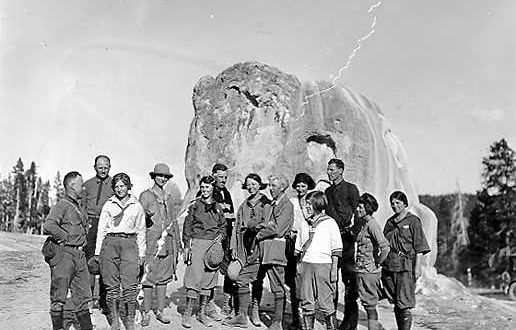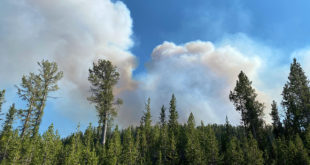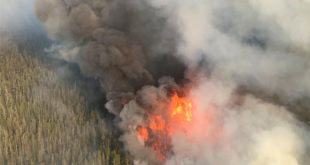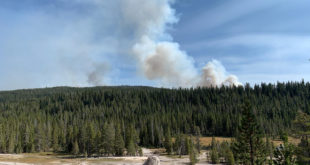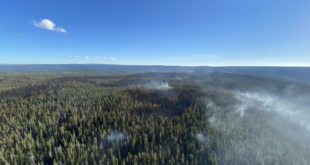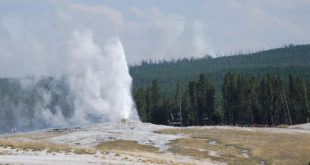We all know the iconic photo location at Yellowstone National Park is Old Faithful during a geyser eruption. But there are plenty of great locations in Yellowstone to capture your own iconic photo. Here are our Top Ten out-of-the-way photo spots to capture that perfect image.
All of these locales are off the beaten path, and some require some serious hikes. Let’s face it: with well over four million Yellowstone visitors in a given year, the Grand Loop Road is some mightily traveled terrain, and the farther off the Grand Loop Road you can make it, the more unique your potential photo opportunities. Whether it be a perfect view of Yellowstone Lake framed by mountains or a moose strolling at the side of a lake, the best places for creating an iconic and potential award-winning photo are worth time and effort on your part. In no particular order, here are our 10 favorite out-of-the-way photo spots in Yellowstone National Park.
1. Lone Star Geyser. Located about two miles off the Grand Loop Road, Lone Star Geyser is a predictable cone geyser, with eruptions reaching 35 to 40 feet every three hours. Because it sits in a relatively open spot sans tourists, you can choose your background without worrying about people in the shot. To get there: park in the Kepler Cascades parking lot and hike or bike the trail to the geyser clearing. (That’s the Lone Star Geyser cone in the 1923 photo at the top of this newsletter, courtesy National Park Service.)
2. Point Sublime. The name fits: The 2.6-mile round trip to Point Sublime past the South Rim Trail and Artist Point leads to some spectacular views of the Grand Canyon of the Yellowstone. True, the Grand Canyon of the Yellowstone is one of the most photogenic areas in the park. But this trail, which runs along the cliffs on the south side of the canyon, yields great views of the rhyolite rock formations making up the canyon.
3. Grand Prismatic Spring. OK, Grand Prismatic Spring isn’t exactly off the beaten path: the largest hot spring in the United States is one of the most photographed spot in Yellowstone National Park. But most of those photos are pretty mediocre: shooting Grand Prismatic Spring from the boardwalk usually can’t capture its breadth and beauty. For a truly unique perspective, head south of the Grand Prismatic Spring and turn into the Fairy Falls parking area. From there, head up the walking path until you’re well above the entire Grand Prismatic Spring, where you’ll get some truly great views of this wonder. (You’ll need to do this in 2017 or perhaps even 2018; the Fairy Falls parking lot, trailhead, and hill access were closed in 2016. Check with a ranger to see if they’re open in 2017.)
4. Blacktail Plateau Drive. Located between Mammoth and Roosevelt on the Grand Loop Road, the six-mile, one-way Blacktail Plateau Drive runs to the south of the Grand Loop Road and is Yellowstone in a nutshell, alternating between forest and meadow. The best time to hit Blacktail Plateau Drive: dawn or desk, when the animals are most active. Blacktail Plateau Drive is also one of the great places to catch a photo of a field of wildflower in full bloom. Be warned it’s often closed for various reasons, including an increased number of bears in the area.
5. Grebe Lake. Grebe Lake is best known in Yellowstone circles for the great fishing for rainbow trout and Arctic grayling, but the hike in can yield some interactions with bear and moose. It’s a long (6.6 miles round trip) haul, but it’s an easy, mostly level hike. The trailhead is between the Norris and Canyon intersections, 3.5 miles west of Canyon on the Norris/Canyon road. If you’re ambitious and want to see the terrain and wildlife in a variety of situations, do some backcountry camping and make the loop of Yellowstone’s Chain of Lakes.
6. Two Ocean Plateau. This is one of the most remote spots in all of the United States. Located in the southeast corner of Yellowstone, Two Ocean Plateau features 15 backcountry camping sites, some great vistas, and over 80 miles of trail. At the core: a marsh that straddles the Continental Divide–hence the name.
7. Dunanda Falls. The Bechler River area of Yellowstone National Park isn’t accessible from the Grand Loop Road: you need to access it from Idaho, via Ashton. Take the Boundary Creek Trail eight miles north of the Bechler Ranger Station, where you’ll find the 110-foot-tall Dunanda Falls. The 16-mile round-trip hike is rated as somewhere between easy and moderate, but it’s easily doable in a day. Your reward: a photogenic waterfall, with the Boundary Creek flowing over the dark volcanic rock. And you’re bound to see some wildlife along the way.
8. Trout Lake. It’s a half-mile steep hike through a Douglas fir forest to one of the most scenic lakes in Yellowstone: the sky-blue water is framed by mountains (which reflect nicely on a calm day), wildflowers and wildlife. The trailhead is located on Highway 212 between the Northeast Entrance and Tower, 1.5 miles south of Pebble Creek Campground.
9. Slough Creek Trail. Located east of Tower on Highway 212 to the Northeast Entrance and Cooke City, the Slough Creek Campsite and Trail is 1.8 miles from the highway, at the end of a dirt road. Many people just drive the road, while others hike up the trail: it’s an easy hike, but you don’t need to go all seven miles in for some scenic sites. This is a great spot for wildlife watching: sightings of wolves, elk, bears, bighorn sheep, badgers and foxes are common.
10. Old Gardiner Road. Save this one for last, as it takes you to the Yellowstone Park North Entrance. This stretch of road runs parallel to the North Entrance/Mammoth road, but it feels like a world away. It’s a one-way road beginning behind the Mammoth Hot Springs hotel. In the morning or dusk you’re likely to encounter some wildlife, such as pronghorn, along the way.
—–
Help celebrate the world’s first national park through the art of photography and public participation by entering the 2nd Annual Yellowstone Forever Photo Contest, sponsored by the Yellowstone Park Foundation and Nature’s Best Photography! With the submission deadline approaching (Monday, Oct. 24), now is the time to prep your entry and help celebrate America’s Best Idea.
“As we join in the celebration of the National Park Service’s Centennial Anniversary in 2016, our goal is to focus on the diverse flora and fauna of Yellowstone National Park through the eyes of park visitors,” says Karen Bates Kress, President of the Yellowstone Park Foundation. “What they have witnessed over the years and the photographs they have taken will surely result in a remarkable body of work.”
The entries are divided into two groups:
Photographers may enter at the following levels:
Amateur (earned less than $5,000 last year from photography)
Youth (18 and under) See all the entry rules here!
 Yellowstone Insider Your Complete Guide to America's First National Park
Yellowstone Insider Your Complete Guide to America's First National Park
